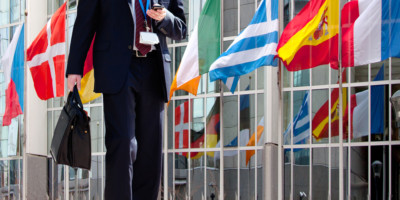-
Allemagne
Germany – eSports gaining ever more significance
13 décembre 2017
- Propriété intellectuelle
- Médias
- Sport
Talking to clients five years ago the trend was clear, application was to be filed for the EU Trademark only, as it was faster, broader, in relation to the geographical scope cheaper and easier to handle. However as we experience now the EU trade mark has some downsides for which reason it is advisable to apply for a national trademark alongside the EU trade mark. And these are the reasons why:
Genuine Use
One of the main risks with trade marks is the fact that they must be used five years after registration. That use however must be genuine. According to the ECJ (C 149/11) “there is ‘genuine use’ of a trade mark where the mark is used in accordance with its essential function, which is to guarantee the identity of the origin of the goods or services for which it is registered, in order to create or preserve an outlet for those goods or services; genuine use does not include token use for the sole purpose of preserving the rights conferred by the mark. When assessing whether use of the trade mark is genuine, regard must be had to all the facts and circumstances relevant to establishing whether there is real commercial exploitation of the mark in the course of trade, particularly the usages regarded as warranted in the economic sector concerned as a means of maintaining or creating market share for the goods or services protected by the mark, the nature of those goods or services, the characteristics of the market and the scale and frequency of use of the mark.“
The problem which occurs from time to time is whether a trade mark used only in one member state or in a specific part of that member state is to be regarded as genuine use in the meaning of these ECJ findings. Whilst the ECJ (C 149/11) has not denied genuine use because of a territorial restricted use within one member state per se it still has not excluded that possibility and what is more has even given the national courts the decision making authority to assess “whether the mark in question is used in accordance with its essential function and for the purpose of creating or maintaining market share for the goods or services protected.“ Consequently a French court could decide that a use of a mark in Germany is insufficient for upholding a EU trade mark and thereby decide that the mark has to be deregistered. This reason alone provides for the necessity to have a national trade mark as plan B.
Counterclaim
When the plaintiff’s trade mark is a German trade mark, there is no possibility for the defendant to raise a counterclaim calling for a revocation of that plaintiff’s trade mark. The defendant has to file for an additional cancellation order before the German Patent and Trademark office. That additional cancellation proceeding however in general does not even bar the violation proceedings. So these will often be decided long before the cancellation proceedings in the last instance.
That is different when it comes to the EU trade mark. The EU trade mark can be declared void during (!) the violation proceedings by filing a counterclaim. Alternatively, the EU trade mark court hearing a counterclaim for revocation or for a declaration of invalidity may stay the proceedings on application by the proprietor of the EU trade mark and after hearing the other parties and may request the defendant to submit an application for revocation or for a declaration of invalidity to the Office. With the consequences that the violation proceeding is dead for ten years which it takes to pursue the cancellation proceedings through all instances.
Place of jurisdiction
The place of jurisdiction of a EU trade mark is limited to the place where the event which gave rise to the harm occurred (“Handlungsort”). The German trade mark however also provides for the place where the harm arose (‘Erfolgsort’) as place of jurisdiction. That however gives the plaintiff much more possibility to forum shop.
Statute of limitation
The EU trade mark does not provide a uniform statute of limitation. The ECJ (C 479/12) has decided that claims for injunctive reliefs become time-bared under the regulations of the national law. However in some case it can be very unclear which national law applies and therefore the same case can be seen differently in the different countries. When the plaintiff’s trade mark is a national trade mark the scope of application of the national statutes of limitation is clear and there are no further insecurities which are never to relish when have court proceedings.
The author of this post is Ilja Czernik.
These days, influencer marketing is an indispensable part of virtually any marketing strategy. The attention gained through influencer marketing has recently been a subject of discussion among the competition associations as well.
As a forerunner, the Association of Social Competition seems prepared to take a closer look at the topic, as indicated by several media statements. According to its general manager Angelika Lange, the association has already issued warnings to several dozen influencers (https://www.wuv.de/marketing/die_influencer_jaeger ).
The association does not shy away from litigation, either. Following Celle Higher Regional Court’s decision on the external presentation of influencer advertising in June 2017, Hagen Regional Court (September 13, 2017 – Case 23 O 30/17) dealt not only with the external presentation but also with the content of an influencer’s statements.
Influencer Scarlett Gartmann is said to have advertised various products on her Instagram account without marking the content or individual sections as “advertising” (“Anzeige”) or “promotion” (“Werbung”). Hagen Regional Court, like Celle Higher Regional Court, considered this a violation of the marking obligations under competition law.
While this decision was to be expected, what is noteworthy is the component that deals with the content. The regional court obviously also had to decide on the use of the term detox by the influencer, which the Court considered a “health claim” in combination with the drink that was advertised by means of a photograph. Such a claim would not be permitted, however, which is why another prohibition claim against the influencer existed.
Practical tip
Particularly in areas that are sensitive to regulatory requirements, such as food law or medical device law, influencers and companies that are commissioning influencers should check in advance whether certain statements can actually be made as planned. Even though the external form can be preserved relatively easily by marking the text as “advertising” or “promotion,” there may be considerable and costly warning potential when the content of statements is examined, which the competition associations increasingly seem intent on exploiting.
The author of this post is Ilja Czernik.
The eSports sector is growing rapidly as illustrated by the following figures:
In 2017, the eSports economy grew to US-$696 million, a year-on-year growth of 41.3%.
Brands invested $517 million in 2017, which is expected to double by 2020.
Worldwide, the global eSports audience reached 385 million in 2017, with 191 million regular viewers.
(cf. https://newzoo.com/insights/trend-reports/global-esports-market-report-2017-light/)
North America continues to be the largest eSports market with revenues of US-$257 million. There is also continual development of eSports in Germany, however. The professional soccer teams of VfL Wolfsburg and FC Schalke 04 have their own eSports teams (http://www.gameswirtschaft.de/sport/esports-fussball-bundesliga/), and the German eSports Federation Deutschland has recently been founded, with the Federal Association of Interactive Entertainment Software (BIU) as a founding member (http://www.horizont.net/marketing/nachrichten/ESBD-E-Sport-Bund-Deutschland-geht-an-den-Start-162957).
In areas where such a lot of money can be made, legal obstacles are never far away. Here, they comprise a wide range of all kinds of different topics.
The initial focus is on copyrights and ancillary copyrights. Soccer stadiums, buildings, and avatars may enjoy copyright protection just as much as the computer program on which the games are based. Another item of discussion is whether eAthletes are to be classified as “performing artists” in accordance with Section 73 German Copyright Act. In addition, the question arises as to who enjoys ancillary copyrights under Section 81 Copyright Act as organizer of eSports events and whether such organizers have the same domiciliary rights as the organizers of a regular sports event.
In terms of trademark and design law, it will have to be discussed to what extent products and brand images represent infringements of the Trademark Act and the Design Act. In the case of brands and trademarks in particular, the question will be to what extent they are design objects or indications of origin.
Finally, there will also be regulatory issues that need to be observed. In addition to the use of cheatbots and doping substances, the main focus will be on the protection of minors and the Interstate Broadcasting Treaty with its advertising restrictions.
In conclusion, one suggestion: keep an eye on the eSports movement! Companies that want to stay ahead of the curve, should deal with the aforementioned issues and all further questions in timely manner.
The author of this post is Ilja Czernik.
Long expected by manufacturers of brand-name products, brick-and-mortar-distributors, internet retailers and online platform providers as Amazon, eBay, Zalando, the Court of Justice of the European Union (CJEU) just decided yesterday on 6 December 2017 – its “Santa Claus decision” – that manufacturers may lawfully ban sales via third party platforms.
In a previous Legalmondo post we analysed this dispute (“the Coty case”) just resolved by the CJEU. According to its decision, such platform ban is not necessarily an unlawful restriction of competition under article 101 Treaty on the Functioning of the European Union (“TFEU”): The court has confirmed that selective distribution systems for luxury goods, which shall primarily preserve the goods’ luxury image may comply with European antitrust law.
More specifically, the court decided that platforms bans are lawful, namely that EU law allows restricting online sales in
“a contractual clause, such as that at issue in the present case, which prohibits authorised distributors of a selective distribution network of luxury goods designed, primarily, to preserve the luxury image of those goods from using, in a discernible manner, third-party platforms for internet sales of the goods in question, provided that the following conditions are met: (i) that clause has the objective of preserving the luxury image of the goods in question; (ii) it is laid down uniformly and not applied in a discriminatory fashion; and (iii) it is proportionate in the light of the objective pursued. It will be for the Oberlandesgericht to determine whether those conditions are met.”
(cf. the CJEU’s press release No. 132/2017).
This is the intermediary result of the Coty case as it is now up to the Higher Regional Court of Frankfurt to apply these requirements in the Coty case. Simply put, the question in that case is whether owners of luxury brands may generally or at least partially ban the resale via internet on third-party platforms. The Coty case’s history is quite interesting: The luxury perfume manufacturer Coty’s German subsidiary Coty Germany GmbH (“Coty”) set up a selective distribution network and its distributors may sell via the Internet – but banned to sell via third party platforms which are externally visible as such, i.e. Amazon, eBay, Zalando & Co. The court of first instance decided that such ban of sales via third party platforms was an unlawful restriction of competition. The court of second instance, however, did not see the answer that clear. Instead, the court requested the CJEU to give a preliminary ruling on how European antitrust rules have to be interpreted, namely article 101 TFEU and article 4 lit. b and c of the Vertical Block Exemptions Regulation or “VBER” (decision of 19.04.2016, for details, see the previous post “eCommerce: restrictions on distributors in Germany”). On 30 March 2017, the hearing took place before the CJEU. Coty defended its platform ban, arguing it aimed at protecting the luxury image of brands such as Marc Jacobs, Calvin Klein or Chloe. The distributor Parfümerie Akzente GmbH instead argued that established platforms such as Amazon and eBay already sold various brand-name products, e.g. of L’Oréal. Accordingly, there was no reason for Coty to ban the resale via these marketplaces. Another argument brought forward against the platform ban was that online platforms were important for small and medium-sized enterprises. Indications on how the court could decide appeared on 26 July 2017, with the Advocate General giving his opinion, concluding that platform bans appear possible, provided that the platform ban depends “on the nature of the product, whether it is determined in a uniform fashion and applied without distinction and whether it goes beyond what is necessary” (see the previous post “Distribution online – Platform bans in selective distribution (The Coty case continues)”).
Practical Conclusions:
- This “Santa Claus decision” of 6 December 2017 is highly important for all manufacturers of brand-name products, brick-and-mortar-distributors, internet retailers and online platform providers – because it clarifies that manufacturers of brand-name products may ban sales via third party platforms (Amazon, eBay, Zalando and Co.) to ensure the same level of quality of distribution throughout all distribution channels, offline and online.
- As a glimpse back in advance: the district court of Amsterdam already on 4 October 2017 decided that Nike’s ban on its selective distributors not to use online platforms as Amazon was a lawful distribution criterion to safeguard Nike’s luxury brand image (case of Nike European Operations Netherlands B.V. vs. the Italy-based retailer Action Sport Soc. Coop, A.R.L., ref. no. C/13/615474 / HA ZA 16-959). More details soon!
- The general ban to use price comparison tools as stipulated by the sporting goods manufacturer Asics in its “Distribution System 1.0“ shall be anti-competitive – according to the Bundeskartellamt, as confirmed by the Higher Regional Court of Düsseldorf on 5 April 2017. The last word is, however, still far from being said – see the post “Ban of Price Comparison Tools anti-competitive & void?”. It will be interesting to see how the Coty case’s outcome will influence how to see such bans on price comparison tools.
- For further trends in distribution online, see the EU Commission’s Final report on the E-commerce Sector Inquiry and details in the Staff Working Document, „Final report on the E-commerce Sector Inquiry“.
- For details on distribution networks and distribution online, please see my articles
- “Internetvertrieb in der EU 2018 ff. – Online-Vertriebsvorgaben von Asics über BMW bis Coty”, in: Zeitschrift für Vertriebsrecht2017, 274-281: and
- „Plattformverbote im Selektivvertrieb – der EuGH-Vorlagebeschluss des OLG Frankfurt vom 19.4.2016“, in: Zeitschrift für Vertriebsrecht 2016,278–283.
The Coty case is extremely relevant to distribution in Europe because more than 70% of the world’s luxury items are sold here, many of them online now. For further implications on existing and future distribution networks and the respective agreements, stay tuned: we will elaborate this argument on Legalmondo!
Influencer marketing is the trend in today’s world of advertising. Even though it is obvious that influencer marketing must observe the framework of applicable statutory provisions, the market has long been uncertain about how influencer posts are to be drafted in order to be legally compliant. The current decision of Celle Higher Regional Court (June 08, 2017 – Case 13 U 53/17) offers at least some clarity.
The judgment was issued in relation to an action for injunction by the German Association for Social Competition (Verband Sozialer Wettbewerb) against a German drugstore chain. A 20-year-old Instagram star with 1.3 million followers had advertised the drugstore chain in one of her posts. The post was only marked as advertisement at the bottom with the hashtag “#ad,” which additionally only came second in a list of six hashtags.
Celle Higher Regional Court adjudged that this type of marking was insufficient. The court requested that the commercial purpose of an Instagram post would have to be apparent at first sight. It did not consider use of the hashtag “#ad” in a “hashtag cloud” to be sufficient to mark the post as advertising.
The court left expressly open, however, whether the use of the hashtag “#ad” is generally suitable to mark advertising posts.
The state media authorities (Landesmedienanstalten) already reacted to the judgment, however, and revised their joint guide on advertising issues in social media. It now reads: “When marking a post as PROMOTION (Werbung) or ADVERTISING (Anzeige), you will be on the safe side – that much is certain. […] At the current time, we cannot recommend marking posts as #ad, #sponsored by, or #powered by.” In the future, Instagram itself intends to provide for more transparency on the platform by comprehensibly identifying advertising posts. It is currently testing the introduction of a branded content tool in Germany to make it easier for users to recognize posts as paid advertising.
Practical tip
Advertising posts in social media should always be marked as “promotion” or “advertising” at the beginning of the posts unless their commercial purpose arises directly from the circumstances. Advertisers are also advised to obligate influencers contractually to such legally compliant marking of posts, since the influencers’ behavior may be attributed to the company, as is clearly shown by the recent judgment of Celle Higher Regional Court against the drugstore chain.
The author of this post is Ilja Czernik.
This post is the last of three small articles on the protection of IP rights in Germany. In the first we have already seen how the German Copyright Act protects creative and artistic works and how Design Patents protects achievements in the aesthetic field. In the second we focused the attention on Trademarks, Patents and Utility Patents, in order to verify how to best protect names, signs and technical inventions.
In this post we will concentrate on how the Act against Unfair Competition grants protection against unfair practices in the course of the business and the main procedural aspects of the IP claims in Germany.
Unfair Competition Law
The Act against Unfair Competition outlaws unfair practices in the course of business by a respective general clause. A number of specific practices are explicitly listed in the Act, in particular misleading advertising and other deceptive practices, psychological pressure, destructive competition and the unfair exploitation of work results (but only under special circumstances). The breach of law can also constitute an unfair practice, provided that the practice is aimed at gaining an unlawful advantage over competitors.
Unfair practices are not controlled by a state authority, but can be prosecuted by any competitor. In addition, private associations which exist for the promotion of commercial or of independent professional interests and qualified entities that are entered on a list of the Injunctions Act or on a list of the EU Commission for the protection of consumer interests may prosecute unfair practices.
Unfair Competition Law is partly harmonized within the EU by a Directive dealing with unfair practices against customers.
Procedural aspects
In German practice, most of the unfair competition and intellectual property claims follow the same pattern:
In case of a suspected infringement, the claimant usually sends a warning letter to the violating party, asking for a cease and desist statement that must be enforceable by a contractual penalty. If the allegation is true, the violating party has to bear the lawyer’s costs for the warning letter.
If the violating party refuses such a statement, the claimant can apply for a temporary injunction. Such an injunction will be granted by the court if the claimant can establish the claim and the urgency of the matter. In practice, the urgency is assumed, if the application has been filed within a short time frame after the applicant became aware of all relevant facts. However, there is no statutory time limit. Some courts deny urgency after more than one month, while other courts consider two months or even more as acceptable.
The addressee of a warning letter should always check the legal allegations and react within the time limit given, otherwise the risk of a temporary injunction without oral hearing is comparatively high. Such a court decision can be very detrimental, as most of unfair competition and intellectual property claims are finally decided or settled in injunctive proceedings.
If a temporary injunction is granted and the violating party does not appeal against the judgement, the claimant usually asks for a termination letter. During this stage, the matter can be settled, otherwise a regular lawsuit will follow.
While a temporary injunction is usually raised to prevent further infringements or the repetition of an unfair practice, the main proceedings can also cover remedy, damage, disclosure and account claims.
An important advantage for the plaintiff is his right to choose the venue. Usually he has the choice between the domicile or seat of the defendant and all places where the infringement or unfair practice has been committed. In particular in internet cases, this can be all over Germany.
Most of the German member states have established special courts and chambers for Intellectual Property and unfair Competition Law. Therefore the quality of decisions in this field of law is usually comparatively high.
Manufacturers of brand-name products typically aim to ensure the same level of quality of distribution throughout all distribution channels, offline and online. To achieve this aim, they provide criteria how to resell their products. With the increase of internet sales, the use of such criteria has been increasing as well.
A total ban of online sales to end consumers within the EU is, however, hardly valid because online sales are considered as passive sales (cf. Guidelines on Vertical Restraints 2010, para. 52). Restrictions below a total ban are, however, commonplace (for examples, see the post “eCommerce: restrictions on distributors in Germany”). Yet, it is still not clear how far such restrictions are permissible.
For example, the luxury perfume manufacturer Coty’s German subsidiary Coty Germany GmbH has set up a selective distribution network and its distributors may sell via the Internet, under the following conditions. They shall
- use their internet store as “electronic store window” of their brick and mortar store(s), thereby maintaining the products’ character as luxury goods, and
- abstain insofar from engaging third parties as such cooperation is externally visible.
The court of first instance decided that tsuch ban of sales via third party platforms was an unlawful restriction of competition under art. 101 Treaty on the Functioning of the European Union (“TFEU”), namely a hardcore restriction under article 4 lit. c Regulation (EU) No. 330/2010 (Vertical Block Exemptions Regulation or “VBER”). The court of second instance, however, does obviously not see the answer that clear. Instead, the court requested the Court of Justice of the European Union (CJEU) to give a preliminary ruling on how European antitrust rules have to be interpreted, namely article 101 TFEU and article 4 lit. b and c VBER (decision of 19.04.2016, ref. no. 11 U 96/14 [Kart]) – see the previous post “eCommerce: restrictions on distributors in Germany”.
On 30 March 2017, the hearing took place before the CJEU:
- Coty defended its platform ban, arguing it aimed at protecting the luxury image of brands such as Marc Jacobs, Calvin Klein or Chloe.
- France – seat of several luxury brands such as Louis Vuitton, Chanel and Christian Dior –supported Coty.
- The distributor instead argued that established platforms such as Amazon and eBay already sold various brand-name products, e.g. of L’Oréal. Accordingly, there was no reason for Coty to ban the resale via these marketplaces. Germany also supported this view by emphasizing the importance of online platforms for small and medium-sized enterprises (where, however, the share of distributors using online marketplaces is 62% much higher than in all other Member States, see the Staff Working Document, „Final report on the E-commerce Sector Inquiry“, para. 452).
- Luxembourg – the seat of Amazon – considers a general platform ban to be disproportionate and therefore as anti-competitive (cf. Reuters’ article here).
Interest in the outcome of the Coty case is widespread, as the active participation of the various EU Member States illustrates (in addition to the abovementioned countries, also Italy, Sweden, the Netherlands and Austria). Simply put, the question is whether owners of luxury brands may generally or at least partially ban the resale via internet on third-party platforms.
Indications on how the court may decide have just appeared on 26 July 2017, with the Advocate General giving his opinion. The Advocate General proposes that the CJEU answers the questions referred to the court as follows:
“(1) Selective distribution systems relating to the distribution of luxury and prestige products and mainly intended to preserve the ‘luxury image’ of those products are an aspect of competition which is compatible with Article 101(1) TFEU provided that resellers are chosen on the basis of objective criteria of a qualitative nature which are determined uniformly for all and applied in a non-discriminatory manner for all potential resellers, that the nature of the product in question, including the prestige image, requires selective distribution in order to preserve the quality of the product and to ensure that it is correctly used, and that the criteria established do not go beyond what is necessary.
(2) In order to determine whether a contractual clause incorporating a prohibition on authorised distributors of a distribution network making use in a discernible manner of third-party platforms for online sales is compatible with Article 101(1) TFEU, it is for the referring court to examine whether that contractual clause is dependent on the nature of the product, whether it is determined in a uniform fashion and applied without distinction and whether it goes beyond what is necessary.
(3 The prohibition imposed on the members of a selective distribution system who operate as retailers on the market from making use in a discernible manner of third undertakings for internet sales does not constitute a restriction of the retailer’s customers within the meaning of Article 4(b) of Commission Regulation (EU) No 330/2010 of 20 April 2010 on the application of Article 101(3) on the Treaty of the Functioning of the European Union to categories of vertical agreements and concerted practices.
(4) The prohibition imposed on the members of a selective distribution system, who operate as retailers on the market, from making use in a discernible manner of third undertakings for internet sales does not constitute a restriction of passive sales to end users within the meaning of Article 4(c) of Regulation No 330/2010.”
The Advocate General’s complete opinion can be found at CJEU’s website here.
The updated overview of the procedure can be found at CJEU’s website here.
Practical Conclusions
- The Coty case is extremely relevant to distribution in Europe because more than 70% of the world’s luxury items are sold here, many of them online now.
- The general ban to use price comparison tools shall be anti-competitive – according to the Bundeskartellamt, as confirmed by the Higher Regional Court of Düsseldorf on 5 April 2017. The last word is, however, still far from being said – see the post “Asics’ Distribution of Sporting Goods: Ban of Price Comparison Tools anti-competitive & void?!?”. Besides, also the Coty case’s outcome may influence how to see such bans.
- The Coty case is setting the course for future Internet sales. Depending on the decision of the CJEU, manufacturers of luxury or brand-name products can continue to ban the use of marketplaces like Amazon or eBay for the distribution of their products – or not any more or only under certain conditions. If the court follows the Advocate General’s conclusions, such platform bans appear possible, provided that the platform ban depends “on the nature of the product, whether it is determined in a uniform fashion and applied without distinction and whether it goes beyond what is necessary” (see above).
- For further trends in distribution online, see the EU Commission’s Final report on the E-commerce Sector Inquiry and details in the Staff Working Document, „Final report on the E-commerce Sector Inquiry“.
- For details on distribution networks and antitrust, please see my article „Plattformverbote im Selektivvertrieb – der EuGH-Vorlagebeschluss des OLG Frankfurt vom 19.4.2016“, in: Zeitschrift für Vertriebsrecht 2016, p. 278–283.
Manufacturers of brand-name products typically aim to ensure the same level of quality of distribution throughout all distribution channels. To achieve this aim, they provide criteria how to resell their products. With the increase of internet sales, the use of such criteria has been increasing as well.
Best example: Asics. Until 2010, the German subsidiary Asics Deutschland GmbH supplied its distributors in Germany without applying special criteria. In 2011, Asics launched a selective distribution system called « Distribution System 1.0« . It provided, inter alia, for a general ban on distributors to use price comparison tools in online sales:
« In addition, the authorized B … distributor is not supposed to … support the functionality of price-comparison tools by providing application-specific interfaces ( » API ») for these price comparison tools. » (translated]
The German Federal Antitrust Authority (“Bundeskartellamt”) has determined by decision of 26 August 2015 that the ban of price-comparison tools against distributors based in Germany was void because it infringed Article 101 (1) TFEU, sec. 1 Act on Restraints of Competition (see the 196-page decision here). Reason given was that such ban would primarily aim at controlling and limiting price competition at the expense of consumers. Asics, instead, filed a complaint before the Higher Regional Court of Düsseldorf to annul the Bundeskartellamt’s decision. Asics argued that this ban was a proportionate quality standard within its « Distribution System 1.0« , aiming at a uniform product presentation.
Now the Higher Regional Court of Düsseldorf on 5 April 2017 confirmed the Bundeskartellamt’s decision that within selective distribution systems the general ban to use price comparison tools was anti-competitive and therefore void (ref. no. VI-Kart 13/15 (V); see also the Bundeskartellamt’s press release in English):
- In particular, the ban of price comparison tools was not exempt from Art. 101 (1) TFEU by way of teleological interpretation (“Tatbestandsreduktion”). According to the court, it was not necessary in order to protect the quality and the product image of the Asics brand (same argumentation as the Higher Regional Court of Frankfurt in its judgment of 22.12.2015, ref. no. 11 U 84/14 regarding Deuter’s functional back-up bags; the Federal Supreme Court will, however, still decide on this, ref. no. KZR 3/16). The court declared that the ban was intended to restrict the buyers, arguing that distributors would be restricted in entering into a price competition with others. The presentation of products in price comparison tools would not damage the quality or brand of Asics products. It would neither give a « flea market impression« , ostensibly also not from the simultaneous presentation of used products. Also, the ban of price comparison tools would not solve the problem of « free-riding« . In any event, the general ban of price comparison tools was not necessary and therefore unlawful.
- The ban would also not be exempt under the Vertical Block Exemption Regulation. Instead, the court argued, the ban would limit passive sales (over the internet) to end customers, contrary to Art. 4 (c) Vertical Block Exemption Regulation (referring to the CJEU decision in the case of Pierre Fabre, 13 October 2011, ref. no. C-439/09). The “equivalence principle” (i.e. restrictions for offline as well as online sales should not be identical, but functionally equivalent) would not apply as there were no comparable functions to price comparison tools in the stationary trade.
- Finally, the ban would also not benefit from the individual exemption under art. 101 (3) TFEU (“efficiency defence”).
Conclusions:
- According to the Higher Regional Court of Düsseldorf, manufacturers might not generally prohibit their distributors from using price comparison tools. At the same time, the court also refused to grant leave to appeal against its decision – which, however, can be challenged separately by way of an appeal (sec. 74, 75 Act on Restraints of Competition).The future development of criteria limiting distributors in reselling online remains open, especially as (i) the Coty case is pending at the CJEU (see below) and (ii) the EU Commission in its sector enquiry into e-commerce currently appears to favour manufacturers of brand-name products (see below).
- The court has explicitly left open – arguing that they were not relevant for its decision – whether
- the ban of search engines is anti-competitive (para. 44 et seq. of the decision);
- the general ban of third-party platforms is anti-competitive (para. 7) – although Asics’ “Distribution System 1.0” also banned third-party platforms such as Amazon or eBay.
- Whether and how manufacturers of luxury or brand-name products can continue to ban their distributing via Amazon, eBay and other marketplaces in general in the future will likely be decided by the CJEU in the coming months – in the case of Coty (see our post “eCommerce: restrictions on distributors in Germany”) where a hearing has been just recently been held end of March 2017.
- Without prejudice to the Coty case, the EU Commission has however, in its sector enquiry into e-commerce of May 2017, declared that
- “marketplace bans do not generally amount to a de facto prohibition on selling online or restrict the effective use of the internet as a sales channel irrespective of the markets concerned …,
- the potential justification and efficiencies reported by manufacturers differ from one product to another …”,
- (absolute) marketplace bans should not be considered as hardcore restrictions within the meaning of Article 4(b) and Article 4(c) of the VBER…,
- the Commission or a national competition authority may decide to withdraw the protection of the VBER in particular cases when justified by the market situation”
(41–43 Final Report on the e-commerce sector inquiry).
Hence, on the basis of the EU Commission’s most recent position, there is room for arguments and creative contract drafting since even general marketplace bans can be compatible with the EU competition rules. However, the courts may see this differently in the single case. Therefore, especially the CJEU with its Coty case (see above) will likely bring more clarity for future online distribution.
EU Court of Justice allows online sales restrictions (Coty case)
6 décembre 2017
-
Allemagne
- Distribution
- e-Commerce
- Commerce international
Talking to clients five years ago the trend was clear, application was to be filed for the EU Trademark only, as it was faster, broader, in relation to the geographical scope cheaper and easier to handle. However as we experience now the EU trade mark has some downsides for which reason it is advisable to apply for a national trademark alongside the EU trade mark. And these are the reasons why:
Genuine Use
One of the main risks with trade marks is the fact that they must be used five years after registration. That use however must be genuine. According to the ECJ (C 149/11) “there is ‘genuine use’ of a trade mark where the mark is used in accordance with its essential function, which is to guarantee the identity of the origin of the goods or services for which it is registered, in order to create or preserve an outlet for those goods or services; genuine use does not include token use for the sole purpose of preserving the rights conferred by the mark. When assessing whether use of the trade mark is genuine, regard must be had to all the facts and circumstances relevant to establishing whether there is real commercial exploitation of the mark in the course of trade, particularly the usages regarded as warranted in the economic sector concerned as a means of maintaining or creating market share for the goods or services protected by the mark, the nature of those goods or services, the characteristics of the market and the scale and frequency of use of the mark.“
The problem which occurs from time to time is whether a trade mark used only in one member state or in a specific part of that member state is to be regarded as genuine use in the meaning of these ECJ findings. Whilst the ECJ (C 149/11) has not denied genuine use because of a territorial restricted use within one member state per se it still has not excluded that possibility and what is more has even given the national courts the decision making authority to assess “whether the mark in question is used in accordance with its essential function and for the purpose of creating or maintaining market share for the goods or services protected.“ Consequently a French court could decide that a use of a mark in Germany is insufficient for upholding a EU trade mark and thereby decide that the mark has to be deregistered. This reason alone provides for the necessity to have a national trade mark as plan B.
Counterclaim
When the plaintiff’s trade mark is a German trade mark, there is no possibility for the defendant to raise a counterclaim calling for a revocation of that plaintiff’s trade mark. The defendant has to file for an additional cancellation order before the German Patent and Trademark office. That additional cancellation proceeding however in general does not even bar the violation proceedings. So these will often be decided long before the cancellation proceedings in the last instance.
That is different when it comes to the EU trade mark. The EU trade mark can be declared void during (!) the violation proceedings by filing a counterclaim. Alternatively, the EU trade mark court hearing a counterclaim for revocation or for a declaration of invalidity may stay the proceedings on application by the proprietor of the EU trade mark and after hearing the other parties and may request the defendant to submit an application for revocation or for a declaration of invalidity to the Office. With the consequences that the violation proceeding is dead for ten years which it takes to pursue the cancellation proceedings through all instances.
Place of jurisdiction
The place of jurisdiction of a EU trade mark is limited to the place where the event which gave rise to the harm occurred (“Handlungsort”). The German trade mark however also provides for the place where the harm arose (‘Erfolgsort’) as place of jurisdiction. That however gives the plaintiff much more possibility to forum shop.
Statute of limitation
The EU trade mark does not provide a uniform statute of limitation. The ECJ (C 479/12) has decided that claims for injunctive reliefs become time-bared under the regulations of the national law. However in some case it can be very unclear which national law applies and therefore the same case can be seen differently in the different countries. When the plaintiff’s trade mark is a national trade mark the scope of application of the national statutes of limitation is clear and there are no further insecurities which are never to relish when have court proceedings.
The author of this post is Ilja Czernik.
These days, influencer marketing is an indispensable part of virtually any marketing strategy. The attention gained through influencer marketing has recently been a subject of discussion among the competition associations as well.
As a forerunner, the Association of Social Competition seems prepared to take a closer look at the topic, as indicated by several media statements. According to its general manager Angelika Lange, the association has already issued warnings to several dozen influencers (https://www.wuv.de/marketing/die_influencer_jaeger ).
The association does not shy away from litigation, either. Following Celle Higher Regional Court’s decision on the external presentation of influencer advertising in June 2017, Hagen Regional Court (September 13, 2017 – Case 23 O 30/17) dealt not only with the external presentation but also with the content of an influencer’s statements.
Influencer Scarlett Gartmann is said to have advertised various products on her Instagram account without marking the content or individual sections as “advertising” (“Anzeige”) or “promotion” (“Werbung”). Hagen Regional Court, like Celle Higher Regional Court, considered this a violation of the marking obligations under competition law.
While this decision was to be expected, what is noteworthy is the component that deals with the content. The regional court obviously also had to decide on the use of the term detox by the influencer, which the Court considered a “health claim” in combination with the drink that was advertised by means of a photograph. Such a claim would not be permitted, however, which is why another prohibition claim against the influencer existed.
Practical tip
Particularly in areas that are sensitive to regulatory requirements, such as food law or medical device law, influencers and companies that are commissioning influencers should check in advance whether certain statements can actually be made as planned. Even though the external form can be preserved relatively easily by marking the text as “advertising” or “promotion,” there may be considerable and costly warning potential when the content of statements is examined, which the competition associations increasingly seem intent on exploiting.
The author of this post is Ilja Czernik.
The eSports sector is growing rapidly as illustrated by the following figures:
In 2017, the eSports economy grew to US-$696 million, a year-on-year growth of 41.3%.
Brands invested $517 million in 2017, which is expected to double by 2020.
Worldwide, the global eSports audience reached 385 million in 2017, with 191 million regular viewers.
(cf. https://newzoo.com/insights/trend-reports/global-esports-market-report-2017-light/)
North America continues to be the largest eSports market with revenues of US-$257 million. There is also continual development of eSports in Germany, however. The professional soccer teams of VfL Wolfsburg and FC Schalke 04 have their own eSports teams (http://www.gameswirtschaft.de/sport/esports-fussball-bundesliga/), and the German eSports Federation Deutschland has recently been founded, with the Federal Association of Interactive Entertainment Software (BIU) as a founding member (http://www.horizont.net/marketing/nachrichten/ESBD-E-Sport-Bund-Deutschland-geht-an-den-Start-162957).
In areas where such a lot of money can be made, legal obstacles are never far away. Here, they comprise a wide range of all kinds of different topics.
The initial focus is on copyrights and ancillary copyrights. Soccer stadiums, buildings, and avatars may enjoy copyright protection just as much as the computer program on which the games are based. Another item of discussion is whether eAthletes are to be classified as “performing artists” in accordance with Section 73 German Copyright Act. In addition, the question arises as to who enjoys ancillary copyrights under Section 81 Copyright Act as organizer of eSports events and whether such organizers have the same domiciliary rights as the organizers of a regular sports event.
In terms of trademark and design law, it will have to be discussed to what extent products and brand images represent infringements of the Trademark Act and the Design Act. In the case of brands and trademarks in particular, the question will be to what extent they are design objects or indications of origin.
Finally, there will also be regulatory issues that need to be observed. In addition to the use of cheatbots and doping substances, the main focus will be on the protection of minors and the Interstate Broadcasting Treaty with its advertising restrictions.
In conclusion, one suggestion: keep an eye on the eSports movement! Companies that want to stay ahead of the curve, should deal with the aforementioned issues and all further questions in timely manner.
The author of this post is Ilja Czernik.
Long expected by manufacturers of brand-name products, brick-and-mortar-distributors, internet retailers and online platform providers as Amazon, eBay, Zalando, the Court of Justice of the European Union (CJEU) just decided yesterday on 6 December 2017 – its “Santa Claus decision” – that manufacturers may lawfully ban sales via third party platforms.
In a previous Legalmondo post we analysed this dispute (“the Coty case”) just resolved by the CJEU. According to its decision, such platform ban is not necessarily an unlawful restriction of competition under article 101 Treaty on the Functioning of the European Union (“TFEU”): The court has confirmed that selective distribution systems for luxury goods, which shall primarily preserve the goods’ luxury image may comply with European antitrust law.
More specifically, the court decided that platforms bans are lawful, namely that EU law allows restricting online sales in
“a contractual clause, such as that at issue in the present case, which prohibits authorised distributors of a selective distribution network of luxury goods designed, primarily, to preserve the luxury image of those goods from using, in a discernible manner, third-party platforms for internet sales of the goods in question, provided that the following conditions are met: (i) that clause has the objective of preserving the luxury image of the goods in question; (ii) it is laid down uniformly and not applied in a discriminatory fashion; and (iii) it is proportionate in the light of the objective pursued. It will be for the Oberlandesgericht to determine whether those conditions are met.”
(cf. the CJEU’s press release No. 132/2017).
This is the intermediary result of the Coty case as it is now up to the Higher Regional Court of Frankfurt to apply these requirements in the Coty case. Simply put, the question in that case is whether owners of luxury brands may generally or at least partially ban the resale via internet on third-party platforms. The Coty case’s history is quite interesting: The luxury perfume manufacturer Coty’s German subsidiary Coty Germany GmbH (“Coty”) set up a selective distribution network and its distributors may sell via the Internet – but banned to sell via third party platforms which are externally visible as such, i.e. Amazon, eBay, Zalando & Co. The court of first instance decided that such ban of sales via third party platforms was an unlawful restriction of competition. The court of second instance, however, did not see the answer that clear. Instead, the court requested the CJEU to give a preliminary ruling on how European antitrust rules have to be interpreted, namely article 101 TFEU and article 4 lit. b and c of the Vertical Block Exemptions Regulation or “VBER” (decision of 19.04.2016, for details, see the previous post “eCommerce: restrictions on distributors in Germany”). On 30 March 2017, the hearing took place before the CJEU. Coty defended its platform ban, arguing it aimed at protecting the luxury image of brands such as Marc Jacobs, Calvin Klein or Chloe. The distributor Parfümerie Akzente GmbH instead argued that established platforms such as Amazon and eBay already sold various brand-name products, e.g. of L’Oréal. Accordingly, there was no reason for Coty to ban the resale via these marketplaces. Another argument brought forward against the platform ban was that online platforms were important for small and medium-sized enterprises. Indications on how the court could decide appeared on 26 July 2017, with the Advocate General giving his opinion, concluding that platform bans appear possible, provided that the platform ban depends “on the nature of the product, whether it is determined in a uniform fashion and applied without distinction and whether it goes beyond what is necessary” (see the previous post “Distribution online – Platform bans in selective distribution (The Coty case continues)”).
Practical Conclusions:
- This “Santa Claus decision” of 6 December 2017 is highly important for all manufacturers of brand-name products, brick-and-mortar-distributors, internet retailers and online platform providers – because it clarifies that manufacturers of brand-name products may ban sales via third party platforms (Amazon, eBay, Zalando and Co.) to ensure the same level of quality of distribution throughout all distribution channels, offline and online.
- As a glimpse back in advance: the district court of Amsterdam already on 4 October 2017 decided that Nike’s ban on its selective distributors not to use online platforms as Amazon was a lawful distribution criterion to safeguard Nike’s luxury brand image (case of Nike European Operations Netherlands B.V. vs. the Italy-based retailer Action Sport Soc. Coop, A.R.L., ref. no. C/13/615474 / HA ZA 16-959). More details soon!
- The general ban to use price comparison tools as stipulated by the sporting goods manufacturer Asics in its “Distribution System 1.0“ shall be anti-competitive – according to the Bundeskartellamt, as confirmed by the Higher Regional Court of Düsseldorf on 5 April 2017. The last word is, however, still far from being said – see the post “Ban of Price Comparison Tools anti-competitive & void?”. It will be interesting to see how the Coty case’s outcome will influence how to see such bans on price comparison tools.
- For further trends in distribution online, see the EU Commission’s Final report on the E-commerce Sector Inquiry and details in the Staff Working Document, „Final report on the E-commerce Sector Inquiry“.
- For details on distribution networks and distribution online, please see my articles
- “Internetvertrieb in der EU 2018 ff. – Online-Vertriebsvorgaben von Asics über BMW bis Coty”, in: Zeitschrift für Vertriebsrecht2017, 274-281: and
- „Plattformverbote im Selektivvertrieb – der EuGH-Vorlagebeschluss des OLG Frankfurt vom 19.4.2016“, in: Zeitschrift für Vertriebsrecht 2016,278–283.
The Coty case is extremely relevant to distribution in Europe because more than 70% of the world’s luxury items are sold here, many of them online now. For further implications on existing and future distribution networks and the respective agreements, stay tuned: we will elaborate this argument on Legalmondo!
Influencer marketing is the trend in today’s world of advertising. Even though it is obvious that influencer marketing must observe the framework of applicable statutory provisions, the market has long been uncertain about how influencer posts are to be drafted in order to be legally compliant. The current decision of Celle Higher Regional Court (June 08, 2017 – Case 13 U 53/17) offers at least some clarity.
The judgment was issued in relation to an action for injunction by the German Association for Social Competition (Verband Sozialer Wettbewerb) against a German drugstore chain. A 20-year-old Instagram star with 1.3 million followers had advertised the drugstore chain in one of her posts. The post was only marked as advertisement at the bottom with the hashtag “#ad,” which additionally only came second in a list of six hashtags.
Celle Higher Regional Court adjudged that this type of marking was insufficient. The court requested that the commercial purpose of an Instagram post would have to be apparent at first sight. It did not consider use of the hashtag “#ad” in a “hashtag cloud” to be sufficient to mark the post as advertising.
The court left expressly open, however, whether the use of the hashtag “#ad” is generally suitable to mark advertising posts.
The state media authorities (Landesmedienanstalten) already reacted to the judgment, however, and revised their joint guide on advertising issues in social media. It now reads: “When marking a post as PROMOTION (Werbung) or ADVERTISING (Anzeige), you will be on the safe side – that much is certain. […] At the current time, we cannot recommend marking posts as #ad, #sponsored by, or #powered by.” In the future, Instagram itself intends to provide for more transparency on the platform by comprehensibly identifying advertising posts. It is currently testing the introduction of a branded content tool in Germany to make it easier for users to recognize posts as paid advertising.
Practical tip
Advertising posts in social media should always be marked as “promotion” or “advertising” at the beginning of the posts unless their commercial purpose arises directly from the circumstances. Advertisers are also advised to obligate influencers contractually to such legally compliant marking of posts, since the influencers’ behavior may be attributed to the company, as is clearly shown by the recent judgment of Celle Higher Regional Court against the drugstore chain.
The author of this post is Ilja Czernik.
This post is the last of three small articles on the protection of IP rights in Germany. In the first we have already seen how the German Copyright Act protects creative and artistic works and how Design Patents protects achievements in the aesthetic field. In the second we focused the attention on Trademarks, Patents and Utility Patents, in order to verify how to best protect names, signs and technical inventions.
In this post we will concentrate on how the Act against Unfair Competition grants protection against unfair practices in the course of the business and the main procedural aspects of the IP claims in Germany.
Unfair Competition Law
The Act against Unfair Competition outlaws unfair practices in the course of business by a respective general clause. A number of specific practices are explicitly listed in the Act, in particular misleading advertising and other deceptive practices, psychological pressure, destructive competition and the unfair exploitation of work results (but only under special circumstances). The breach of law can also constitute an unfair practice, provided that the practice is aimed at gaining an unlawful advantage over competitors.
Unfair practices are not controlled by a state authority, but can be prosecuted by any competitor. In addition, private associations which exist for the promotion of commercial or of independent professional interests and qualified entities that are entered on a list of the Injunctions Act or on a list of the EU Commission for the protection of consumer interests may prosecute unfair practices.
Unfair Competition Law is partly harmonized within the EU by a Directive dealing with unfair practices against customers.
Procedural aspects
In German practice, most of the unfair competition and intellectual property claims follow the same pattern:
In case of a suspected infringement, the claimant usually sends a warning letter to the violating party, asking for a cease and desist statement that must be enforceable by a contractual penalty. If the allegation is true, the violating party has to bear the lawyer’s costs for the warning letter.
If the violating party refuses such a statement, the claimant can apply for a temporary injunction. Such an injunction will be granted by the court if the claimant can establish the claim and the urgency of the matter. In practice, the urgency is assumed, if the application has been filed within a short time frame after the applicant became aware of all relevant facts. However, there is no statutory time limit. Some courts deny urgency after more than one month, while other courts consider two months or even more as acceptable.
The addressee of a warning letter should always check the legal allegations and react within the time limit given, otherwise the risk of a temporary injunction without oral hearing is comparatively high. Such a court decision can be very detrimental, as most of unfair competition and intellectual property claims are finally decided or settled in injunctive proceedings.
If a temporary injunction is granted and the violating party does not appeal against the judgement, the claimant usually asks for a termination letter. During this stage, the matter can be settled, otherwise a regular lawsuit will follow.
While a temporary injunction is usually raised to prevent further infringements or the repetition of an unfair practice, the main proceedings can also cover remedy, damage, disclosure and account claims.
An important advantage for the plaintiff is his right to choose the venue. Usually he has the choice between the domicile or seat of the defendant and all places where the infringement or unfair practice has been committed. In particular in internet cases, this can be all over Germany.
Most of the German member states have established special courts and chambers for Intellectual Property and unfair Competition Law. Therefore the quality of decisions in this field of law is usually comparatively high.
Manufacturers of brand-name products typically aim to ensure the same level of quality of distribution throughout all distribution channels, offline and online. To achieve this aim, they provide criteria how to resell their products. With the increase of internet sales, the use of such criteria has been increasing as well.
A total ban of online sales to end consumers within the EU is, however, hardly valid because online sales are considered as passive sales (cf. Guidelines on Vertical Restraints 2010, para. 52). Restrictions below a total ban are, however, commonplace (for examples, see the post “eCommerce: restrictions on distributors in Germany”). Yet, it is still not clear how far such restrictions are permissible.
For example, the luxury perfume manufacturer Coty’s German subsidiary Coty Germany GmbH has set up a selective distribution network and its distributors may sell via the Internet, under the following conditions. They shall
- use their internet store as “electronic store window” of their brick and mortar store(s), thereby maintaining the products’ character as luxury goods, and
- abstain insofar from engaging third parties as such cooperation is externally visible.
The court of first instance decided that tsuch ban of sales via third party platforms was an unlawful restriction of competition under art. 101 Treaty on the Functioning of the European Union (“TFEU”), namely a hardcore restriction under article 4 lit. c Regulation (EU) No. 330/2010 (Vertical Block Exemptions Regulation or “VBER”). The court of second instance, however, does obviously not see the answer that clear. Instead, the court requested the Court of Justice of the European Union (CJEU) to give a preliminary ruling on how European antitrust rules have to be interpreted, namely article 101 TFEU and article 4 lit. b and c VBER (decision of 19.04.2016, ref. no. 11 U 96/14 [Kart]) – see the previous post “eCommerce: restrictions on distributors in Germany”.
On 30 March 2017, the hearing took place before the CJEU:
- Coty defended its platform ban, arguing it aimed at protecting the luxury image of brands such as Marc Jacobs, Calvin Klein or Chloe.
- France – seat of several luxury brands such as Louis Vuitton, Chanel and Christian Dior –supported Coty.
- The distributor instead argued that established platforms such as Amazon and eBay already sold various brand-name products, e.g. of L’Oréal. Accordingly, there was no reason for Coty to ban the resale via these marketplaces. Germany also supported this view by emphasizing the importance of online platforms for small and medium-sized enterprises (where, however, the share of distributors using online marketplaces is 62% much higher than in all other Member States, see the Staff Working Document, „Final report on the E-commerce Sector Inquiry“, para. 452).
- Luxembourg – the seat of Amazon – considers a general platform ban to be disproportionate and therefore as anti-competitive (cf. Reuters’ article here).
Interest in the outcome of the Coty case is widespread, as the active participation of the various EU Member States illustrates (in addition to the abovementioned countries, also Italy, Sweden, the Netherlands and Austria). Simply put, the question is whether owners of luxury brands may generally or at least partially ban the resale via internet on third-party platforms.
Indications on how the court may decide have just appeared on 26 July 2017, with the Advocate General giving his opinion. The Advocate General proposes that the CJEU answers the questions referred to the court as follows:
“(1) Selective distribution systems relating to the distribution of luxury and prestige products and mainly intended to preserve the ‘luxury image’ of those products are an aspect of competition which is compatible with Article 101(1) TFEU provided that resellers are chosen on the basis of objective criteria of a qualitative nature which are determined uniformly for all and applied in a non-discriminatory manner for all potential resellers, that the nature of the product in question, including the prestige image, requires selective distribution in order to preserve the quality of the product and to ensure that it is correctly used, and that the criteria established do not go beyond what is necessary.
(2) In order to determine whether a contractual clause incorporating a prohibition on authorised distributors of a distribution network making use in a discernible manner of third-party platforms for online sales is compatible with Article 101(1) TFEU, it is for the referring court to examine whether that contractual clause is dependent on the nature of the product, whether it is determined in a uniform fashion and applied without distinction and whether it goes beyond what is necessary.
(3 The prohibition imposed on the members of a selective distribution system who operate as retailers on the market from making use in a discernible manner of third undertakings for internet sales does not constitute a restriction of the retailer’s customers within the meaning of Article 4(b) of Commission Regulation (EU) No 330/2010 of 20 April 2010 on the application of Article 101(3) on the Treaty of the Functioning of the European Union to categories of vertical agreements and concerted practices.
(4) The prohibition imposed on the members of a selective distribution system, who operate as retailers on the market, from making use in a discernible manner of third undertakings for internet sales does not constitute a restriction of passive sales to end users within the meaning of Article 4(c) of Regulation No 330/2010.”
The Advocate General’s complete opinion can be found at CJEU’s website here.
The updated overview of the procedure can be found at CJEU’s website here.
Practical Conclusions
- The Coty case is extremely relevant to distribution in Europe because more than 70% of the world’s luxury items are sold here, many of them online now.
- The general ban to use price comparison tools shall be anti-competitive – according to the Bundeskartellamt, as confirmed by the Higher Regional Court of Düsseldorf on 5 April 2017. The last word is, however, still far from being said – see the post “Asics’ Distribution of Sporting Goods: Ban of Price Comparison Tools anti-competitive & void?!?”. Besides, also the Coty case’s outcome may influence how to see such bans.
- The Coty case is setting the course for future Internet sales. Depending on the decision of the CJEU, manufacturers of luxury or brand-name products can continue to ban the use of marketplaces like Amazon or eBay for the distribution of their products – or not any more or only under certain conditions. If the court follows the Advocate General’s conclusions, such platform bans appear possible, provided that the platform ban depends “on the nature of the product, whether it is determined in a uniform fashion and applied without distinction and whether it goes beyond what is necessary” (see above).
- For further trends in distribution online, see the EU Commission’s Final report on the E-commerce Sector Inquiry and details in the Staff Working Document, „Final report on the E-commerce Sector Inquiry“.
- For details on distribution networks and antitrust, please see my article „Plattformverbote im Selektivvertrieb – der EuGH-Vorlagebeschluss des OLG Frankfurt vom 19.4.2016“, in: Zeitschrift für Vertriebsrecht 2016, p. 278–283.
Manufacturers of brand-name products typically aim to ensure the same level of quality of distribution throughout all distribution channels. To achieve this aim, they provide criteria how to resell their products. With the increase of internet sales, the use of such criteria has been increasing as well.
Best example: Asics. Until 2010, the German subsidiary Asics Deutschland GmbH supplied its distributors in Germany without applying special criteria. In 2011, Asics launched a selective distribution system called « Distribution System 1.0« . It provided, inter alia, for a general ban on distributors to use price comparison tools in online sales:
« In addition, the authorized B … distributor is not supposed to … support the functionality of price-comparison tools by providing application-specific interfaces ( » API ») for these price comparison tools. » (translated]
The German Federal Antitrust Authority (“Bundeskartellamt”) has determined by decision of 26 August 2015 that the ban of price-comparison tools against distributors based in Germany was void because it infringed Article 101 (1) TFEU, sec. 1 Act on Restraints of Competition (see the 196-page decision here). Reason given was that such ban would primarily aim at controlling and limiting price competition at the expense of consumers. Asics, instead, filed a complaint before the Higher Regional Court of Düsseldorf to annul the Bundeskartellamt’s decision. Asics argued that this ban was a proportionate quality standard within its « Distribution System 1.0« , aiming at a uniform product presentation.
Now the Higher Regional Court of Düsseldorf on 5 April 2017 confirmed the Bundeskartellamt’s decision that within selective distribution systems the general ban to use price comparison tools was anti-competitive and therefore void (ref. no. VI-Kart 13/15 (V); see also the Bundeskartellamt’s press release in English):
- In particular, the ban of price comparison tools was not exempt from Art. 101 (1) TFEU by way of teleological interpretation (“Tatbestandsreduktion”). According to the court, it was not necessary in order to protect the quality and the product image of the Asics brand (same argumentation as the Higher Regional Court of Frankfurt in its judgment of 22.12.2015, ref. no. 11 U 84/14 regarding Deuter’s functional back-up bags; the Federal Supreme Court will, however, still decide on this, ref. no. KZR 3/16). The court declared that the ban was intended to restrict the buyers, arguing that distributors would be restricted in entering into a price competition with others. The presentation of products in price comparison tools would not damage the quality or brand of Asics products. It would neither give a « flea market impression« , ostensibly also not from the simultaneous presentation of used products. Also, the ban of price comparison tools would not solve the problem of « free-riding« . In any event, the general ban of price comparison tools was not necessary and therefore unlawful.
- The ban would also not be exempt under the Vertical Block Exemption Regulation. Instead, the court argued, the ban would limit passive sales (over the internet) to end customers, contrary to Art. 4 (c) Vertical Block Exemption Regulation (referring to the CJEU decision in the case of Pierre Fabre, 13 October 2011, ref. no. C-439/09). The “equivalence principle” (i.e. restrictions for offline as well as online sales should not be identical, but functionally equivalent) would not apply as there were no comparable functions to price comparison tools in the stationary trade.
- Finally, the ban would also not benefit from the individual exemption under art. 101 (3) TFEU (“efficiency defence”).
Conclusions:
- According to the Higher Regional Court of Düsseldorf, manufacturers might not generally prohibit their distributors from using price comparison tools. At the same time, the court also refused to grant leave to appeal against its decision – which, however, can be challenged separately by way of an appeal (sec. 74, 75 Act on Restraints of Competition).The future development of criteria limiting distributors in reselling online remains open, especially as (i) the Coty case is pending at the CJEU (see below) and (ii) the EU Commission in its sector enquiry into e-commerce currently appears to favour manufacturers of brand-name products (see below).
- The court has explicitly left open – arguing that they were not relevant for its decision – whether
- the ban of search engines is anti-competitive (para. 44 et seq. of the decision);
- the general ban of third-party platforms is anti-competitive (para. 7) – although Asics’ “Distribution System 1.0” also banned third-party platforms such as Amazon or eBay.
- Whether and how manufacturers of luxury or brand-name products can continue to ban their distributing via Amazon, eBay and other marketplaces in general in the future will likely be decided by the CJEU in the coming months – in the case of Coty (see our post “eCommerce: restrictions on distributors in Germany”) where a hearing has been just recently been held end of March 2017.
- Without prejudice to the Coty case, the EU Commission has however, in its sector enquiry into e-commerce of May 2017, declared that
- “marketplace bans do not generally amount to a de facto prohibition on selling online or restrict the effective use of the internet as a sales channel irrespective of the markets concerned …,
- the potential justification and efficiencies reported by manufacturers differ from one product to another …”,
- (absolute) marketplace bans should not be considered as hardcore restrictions within the meaning of Article 4(b) and Article 4(c) of the VBER…,
- the Commission or a national competition authority may decide to withdraw the protection of the VBER in particular cases when justified by the market situation”
(41–43 Final Report on the e-commerce sector inquiry).
Hence, on the basis of the EU Commission’s most recent position, there is room for arguments and creative contract drafting since even general marketplace bans can be compatible with the EU competition rules. However, the courts may see this differently in the single case. Therefore, especially the CJEU with its Coty case (see above) will likely bring more clarity for future online distribution.



























